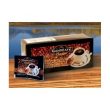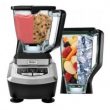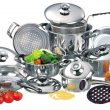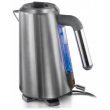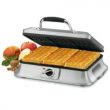One of the most common rookie mistakes when making coffee is to use pre-ground beans. People line up in super markets en masse to purchase coffee grounds. However, coffee begins losing its flavor the second it is ground. Therefore, if you want the perfect cup of coffee you need to grind your beans immediately before you brew your cup. Today there are a huge variety of options for coffee grinders on the market. In this article we’ll break down the different kinds of grinders to help you find the best coffee grinder for your kitchen.
Types of Grinders
There are two basic groups of coffee grinders: blade grinders and burr grinders. Blade grinders are the common grinders than you find in department stores and small coffee shops. They are smaller in size and usually very cheap. Blade grinders are not as preferable however, despite the tempting price. Blade grinders work by literally chopping the coffee beans up into little pieces. In order to adjust the size of the grounds, you have to watch them as you grind them. The longer it grinds, the more fine the particles will be.
While burr grinder’s benefits outweigh their cons, there are a few uses for blade grinders. If you’re in a pinch, blade grinders tend to be available and much cheaper than burr grinders. If you find yourself pinched for space and aren’t as picky about the quality of your coffee, a small blade grinder will likely fit your needs just fine. On top of that, blade grinders tend to last forever and aren’t likely to break down. They’re also great for travel, as they don’t take up much space.
Burr grinders work by literally smashing the coffee into little bits between a grinding wheel: a true grind. Burr grinders are preferable to blade grinders for a variety of reasons. Burr grinders produce a much more consistent grind than blade grinders do. Have you ever noticed that coffee ground with a blade grinder will have large grinds and also fine small ones? Burr grinders eliminate this problem by producing evenly size bits. On top of that, it’s possible to adjust the size of the particles you are grinding.
Burr Grinders
There are two kinds of burr grinders: conical burrs and flat burrs. What is the difference between the two? Conical burr grinders tend to be lower-end to medium end grinders, while flat burr grinders tend to be higher end. Which should you select? There isn’t exactly a clear consensus. Aficionados claim that conical grinders make better grounds for espresso. Others claim that flat burrs produce a better flavor than conical grinders. Research both types thoroughly as you make your choice.
There are also two different materials that may make up grinders: steel and ceramic. There are pros and cons to both. Steel grinders are typically cheap to replace when they wear out. They also tend to be more durable in the short run. However, long term they wear much faster than ceramic burrs. Ceramic burrs are more prone to breakage, but last longer in the long run and tend to produce a better grind. Ceramic burrs are also generally more expensive than steel. When considering a burr, also keep in mind whether or not the grinder is stepped or stepless. Grinders typically allow you to adjust the grind size with a lever. Many grinders operate with preset notches to give you different grind sizes. However, adjusting between the notches is impossible for some grinders. This may not be an issue, but for minute adjustments such as espresso, this can be important. Stepless grinders allow you to adjust between the notches, or are not limited by them.
The next consideration must be where you want the newly ground coffee to go. Coffee grinders with dosers are built with containers that the grounds fall into as they are ground. There is typically a lever that dispenses the grounds from it, allowing you to grind some beans and then get small amounts of the grounds. Doserless grinders will not feature such a container. If you want to come up with your own solution to where the grinds go after the coffee is ground, you may want to look into a doserless grinder.

